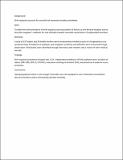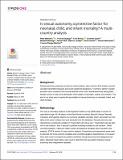| dc.description.abstract | Background: Prolonged hospital length of stay for neonates admitted to the newborn unit is a public health concern. Prolonged stay within the hospital exposes neonates to infection and increased healthcare costs. Objective:To assess the determinants of length of length of stay and neonatal mortality among neonates admitted to the Newborn Unit of Wajir County Referral Hospital. Methodology:A facility-based cross-sectional study design were employed to collect quantitative data from 122 mothers and their neonates admitted to newborn unit. The consecutive sampling technique was used to recruit participants who met the inclusion criteria and consented to the study. Data was collected using a structured questionnaire tools and analyzed using StatisticalPackageforSocialSciences(SPSS) version 26 software. Descriptive and inferential statistical techniques was applied for all variables. Bivariate and multivariable logistic regression analysis with odds ratio and 95% Confidence interval were calculated to assess the determinants of length of stay and neonatal mortality and associated factors. Results:Majority (77.9%) of the mothers whose neonates were admitted to the NBU came from different parts of the vast Wajir County. Majority (59%) of the respondents reside in urban areas and had no formal education 92 (75.4%) and largely unemployed 107 (87.7%). Half (52.5%) of PUBLIC HEALTH public Health the respondents were aged between 21 to 26 years (±0.5). The study revealed a neonatal mortality rate of 12.3%. The bivariate analysis of length of stay show that the obstetrics complications, mode of delivery, sex of neonate, prematurity, low birth weight, complication during and post-delivery, hospital quality of service, staff attitude, as the contributory factors associated with prolonged length of stay. While neonatal mortality is associated with lack of ANC attendance, obstetrics complications, sex of neonate, prematurity, low birth weight, and complication during delivery. A multivariable logistic regression showed that the gestation age (AOR = 7.133; 95% CI(0.000, 0.000): P<0.000) birth weight (AOR = 2417; 95% CI(58, 99.95): P<0.000), Complications during delivery (AOR = 11.469 (1.489, 88.33),95%CI: P<0.019), Lack of ANC attendance (AOR = 0.028; 95% CI (0.003, 0.227): P<0.001) were significantly associated with length of stay and neonatal mortality. The three leading causes of admission and neonatal mortality were found to be Perinatal Asphyxia 40 (32.8%), respiratory distress syndrome (RDS) 18 (14.8%) and Neonatal Sepsis 15 (12.3%). Conclusions: The study has shown that premature and low birth weight as the leading cause of neonatal mortality and that the higher the number of ANC visits the lower the length of hospital stay. The deaths among the preterm and low birth weights occur early in life due to preventable causes, which can be averted through implementation of enhanced intrapartum and immediate postpartum care interventions targeting the leading causes of neonatal mortality of perinatal asphyxia, respiratory distress syndrome and neonatal sepsis. | en_US |




